Meat slicing is an essential culinary skill, ensuring even, precise cuts․ Proper tools and techniques transform raw ingredients into visually appealing dishes․ Freezing meat slightly can simplify the process, while sharp knives and a steady hand guarantee clean cuts․ This guide explores the fundamentals of slicing, helping you achieve consistent, professional results for any dish․
Why Proper Slicing Matters
Proper meat slicing enhances texture, presentation, and flavor in dishes․ Thin, even cuts ensure consistent cooking and a better dining experience․ Uniform slices prevent overcooking in some areas and undercooking in others․ Additionally, proper slicing preserves the meat’s natural tenderness and prevents chewing difficulties․ It also allows for efficient use of ingredients, reducing waste․ Moreover, even cuts contribute to a visually appealing presentation, making meals more enjoyable․ Mastering slicing techniques elevates both home and professional cooking, ensuring dishes are served at their best quality and safety․

Essential Tools for Meat Slicing
A sharp chef’s knife or slicer is crucial for precise cuts․ A sturdy cutting board and optional meat slicer enhance efficiency․ Invest in quality tools for optimal results․
Knives and Cutting Equipment
The right tools are vital for precise meat slicing․ A sharp chef’s knife or boning knife is ideal for thin cuts, while a meat slicer offers uniformity․ Ensure blades are sharp, as dull knives tear meat․ A Granton-edge knife prevents sticking, and a cutting board provides stability․ For tougher cuts, consider a serrated knife․ Optional tools like a slicing guide or sharpener enhance accuracy and maintain blade quality․ Proper equipment ensures safe, efficient slicing and professional results․ Regular maintenance, like sharpening, is key to optimal performance and longevity of your tools․
Mastering Basic Slicing Techniques
Learn to slice meat with precision by cutting against the grain for tenderness․ Use a rocking motion with your knife for even, consistent results․ Practice ensures mastery․
Slicing Against the Grain
Slicing meat against the grain ensures tenderness by cutting through muscle fibers․ Identify the grain direction by observing the lines on the meat’s surface․ Hold your knife at a slight angle and make smooth, even cuts perpendicular to the grain․ This technique is especially crucial for tougher cuts like brisket or flank steak, as it breaks down the fibers, resulting in a more palatable texture․ Practice this method consistently to achieve uniform, tender slices every time․ It enhances both flavor and dining experience, making dishes more enjoyable․
Using a Rocking Motion
A rocking motion is a key technique for slicing meat evenly․ Hold the knife firmly and place it at the desired angle․ Gently rock the blade back and forth, applying light pressure, while moving it across the meat․ This method ensures smooth, consistent cuts, especially for tougher cuts of meat․ Keep your fingers curled and away from the blade for safety․ The rocking motion helps maintain control and precision, resulting in uniform slices․ Practice this technique to enhance your slicing skills and achieve professional-quality results in the kitchen․
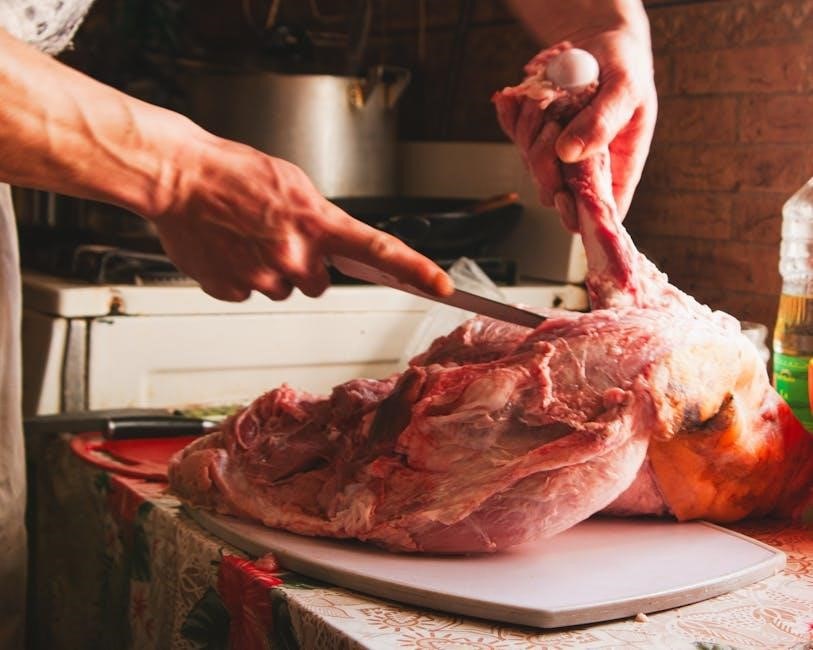
Understanding Different Meat Types
Understanding different meat types is crucial for effective slicing․ Beef, pork, and poultry require varied techniques due to differences in grain, tenderness, and fat content․ This knowledge aids in selecting the right tools and methods, ensuring optimal texture and presentation․
Beef: Cuts and Techniques
Beef offers a variety of cuts, each requiring specific slicing techniques․ Tender cuts like tenderloin and top sirloin are ideal for thin, even slices, while tougher cuts like brisket benefit from slicing against the grain․ For precise results, slightly freeze the beef to firm it up, then use a sharp knife to achieve uniform thickness․ This ensures the meat cooks evenly and maintains its tenderness; Proper slicing enhances both flavor and presentation, making it a key step in preparing dishes like stir-fries or roasts․
Pork: Tender and Tough Cuts
Pork offers a range of cuts, from tender loin and tenderloin to tougher cuts like pork belly; For tender cuts, slice thinly and evenly, ensuring uniform thickness․ Tougher cuts benefit from slicing against the grain to enhance tenderness․ Always use a sharp knife and slightly freeze the meat for easier handling․ Even slices ensure consistent cooking and better presentation, making pork a versatile choice for various dishes․ Proper technique guarantees flavorful and visually appealing results․
Poultry: Safe Slicing Practices
Slicing poultry requires precision and care to ensure food safety and even results․ Always use a sharp, dedicated knife and cutting board to prevent cross-contamination․ Let cooked poultry rest before slicing to retain juices․ Slice against the grain for tender cuts, especially for turkey or chicken breasts․ Keep your fingers curled under and away from the blade for safety․ Clean all tools thoroughly after use to avoid bacterial spread․ Proper slicing enhances both flavor and presentation, making poultry a delightful centerpiece for any meal․
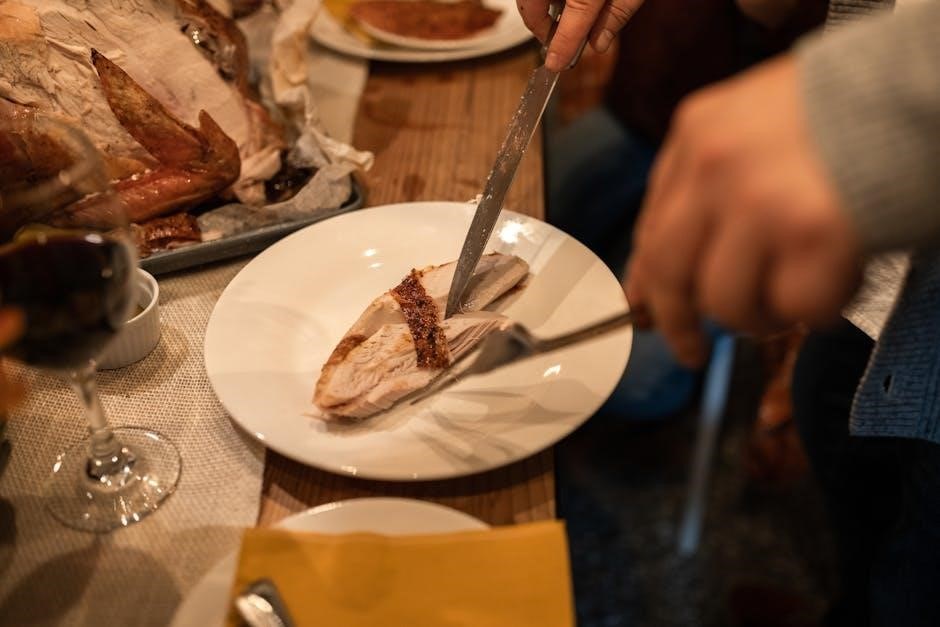
Safety Tips in the Kitchen
Ensure a secure grip on knives and keep fingers curled inward․ Maintain a clean workspace to prevent accidents․ Handle sharp tools with care, and always slice away from your body․ Proper storage of knives and equipment is crucial for safety․ Regularly sanitize cutting boards and utensils to maintain hygiene standards․ Stay alert to avoid slips and cuts, and always supervise children in the kitchen․ A safe environment fosters confidence and efficiency while preparing meals․
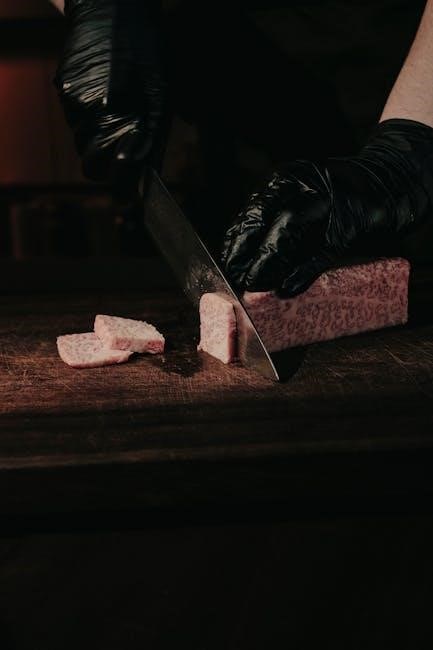
Proper Knife Handling
Proper knife handling is crucial for safety and efficiency․ Hold the knife firmly with a balanced grip, ensuring control․ Keep fingers curled under and out of the blade’s path․ Use a rocking motion for slicing, applying gentle pressure․ Always cut away from the body and maintain a clean, stable cutting board․ Store knives in a safe place, such as a block or sheath, to prevent accidents․ Regularly sharpen knives to maintain effectiveness and reduce the risk of slipping․ Proper handling ensures precise cuts and minimizes hazards in the kitchen․
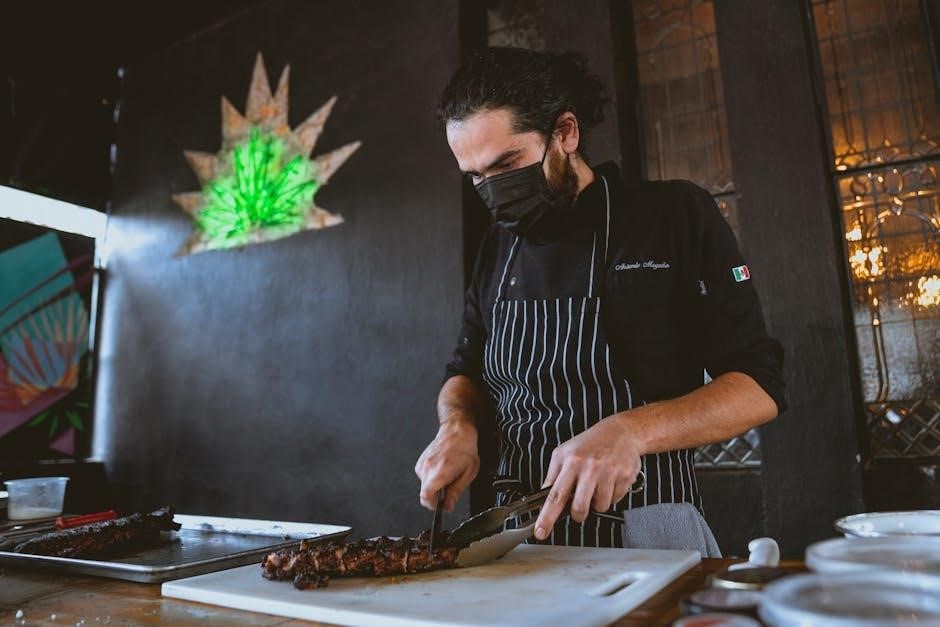
Enhancing Meat Presentation
Enhancing meat presentation elevates dishes visually․ Even, consistent slices create an appealing appearance․ Arrange meat attractively on a platter, garnished with fresh herbs or sauces for a professional finish․
Even and Consistent Slices
Achieving even and consistent slices enhances both the visual appeal and texture of meat․ Use a sharp knife and maintain a steady, controlled motion to ensure uniform cuts․ Slightly freezing the meat firms it, making it easier to slice thinly․ Always cut against the grain for tender results․ For precise control, consider using a meat slicer or mandoline․ Consistent slicing ensures dishes like stir-fries and sandwiches are flavorful and visually appealing, while also improving overall presentation․
The Role of Freezing in Slicing
Freezing meat slightly firms it, making it easier to slice thinly and evenly․ This technique ensures precise cuts and prevents tearing, especially for delicate or tough cuts․
Freezing for Easier Slicing
Freezing meat slightly before slicing enhances precision and ease․ It firms the texture, making it less prone to tearing and allowing for uniform, thin cuts․ This method is especially useful for tougher cuts like brisket or flank steak, as it helps achieve consistent slices․ Ensure the meat is frozen just enough to stiffen but not fully solidify, typically 30 minutes to an hour․ This technique is a game-changer for achieving professional-grade results at home․
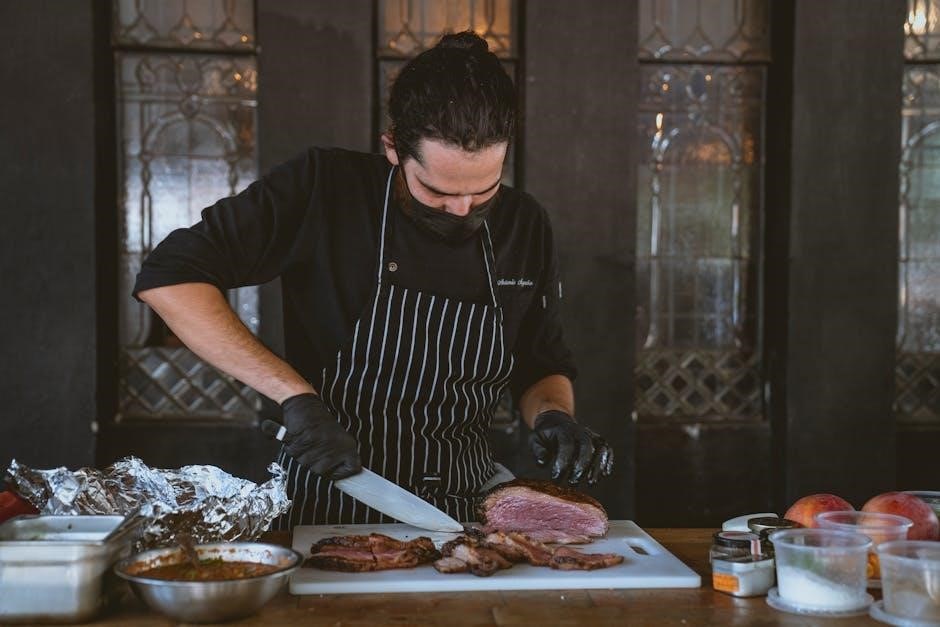
Expert Tips for Perfect Slices
Expert tips emphasize using sharp knives for clean cuts․ Maintain a consistent angle and use smooth, rocking motions for even slices․ Proper knife handling ensures precision and safety․
Chef-Recommended Techniques
Chefs stress the importance of using a sharp knife for precise cuts․ Freezing meat slightly enhances control, especially for thin slices․ Employing a rocking motion ensures evenness, while maintaining a consistent angle prevents uneven edges․ For tougher cuts, slicing against the grain is crucial for tenderness․ Resting the meat before slicing helps retain juices, resulting in a more flavorful dish․ These techniques, combined with practice, elevate slicing to a professional level, ensuring every cut is both visually appealing and delicious․



